![]()
Tools
Object Snap >
The menu versions turn the object snaps on for one pick only.
For persistent object snaps, use the Osnap control.
| Toolbar | Menu |
|---|---|
|
|
Tools Object Snap > The menu versions turn the object snaps on for one pick only. |
The object snaps constrain the marker to an exact location on an object such as the end of a line or the center of a circle.
When Rhino asks you to choose a point, you can constrain the marker to specific parts of existing objects by turning on object snap modes. When an object snap is active, moving the cursor near a specified point on an object causes the marker to jump to that point.
Object snaps can persist from pick to pick, or can be activated for one pick only. Multiple persistent object snaps can be set in the Osnap control. All object snaps behave similarly, but snap to different parts of existing geometry.
For example, the End object snap finds the endpoint of a curve. When activated, the end object snap constrains the marker to the endpoint of the curve closest the cursor.
More than one object snap can be active at the same time. As the cursor passes over an object, the appropriate object snap displays.
Use persistent objects snaps to maintain an object snap through choosing several points without having to reactivate the object snap. Only Cen, End, Int, Knot, Mid, Near, Perp, Point, Quad, Tan, and Vertex object snaps can persist.
You can set the Snap radius for object snaps. This means how close you have to move the cursor to the point before the marker jumps to the point.
One-shot object snaps only work when Rhino is requesting a point, are turned on for one pick only, and override all persistent object snaps for that pick.
When object snaps are on, click and hold near object snap locations to use them for the start or end locations of the drag.
To suspend object snaps for the drag, press and hold Alt.
The Project button on the Osnap control projects any object snap to the current construction plane. For example, in the illustration, the curve projects to the construction plane from snapped locations on an object.
See: ProjectOsnap
Simple object snaps snap to one location on an object.
If a command is active, NoSnap turns off persistent object snaps for one pick.
Snap to the center of a circle, arc, closed polyline, centers of single surfaces with a polyline outer boundary and no holes, and annotation text bounding box.
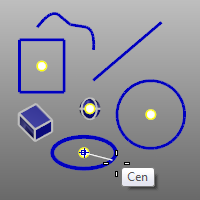
Snap to the end of a curve, text corners, interior vertices of polylines and joined curves, the seam point on closed curves, and the "corners" of surfaces, and polysurfaces.
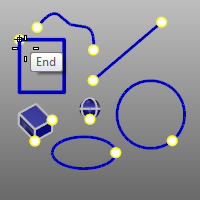
Snap to the intersections of curves, edges, and isoparametric curves on a surface.
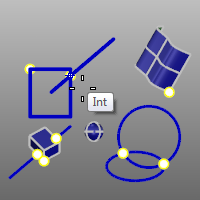
Snap to a knot on a curve or surface.
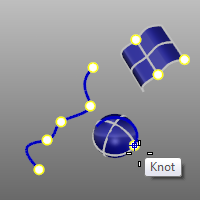
Snap to the midpoint of a curve, surface edge, or a segment of a polycurve.
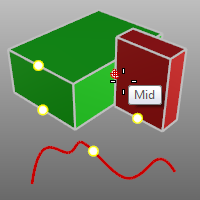
Snap onto a curve or surface edge at the cursor location.
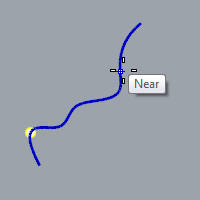
Snap perpendicular to a curve or surface edge.
The Perpendicular object snap is not effective for the first point for a command.
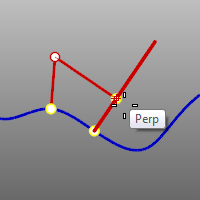
Snap to a point object, extrusion axis, control point, edit point, block, and text insertion points.
Also snaps to centers and corners of rectangular lights and block insertion points even if control points are not displayed.

Snap to the point on a curve that is at the maximum x or y point relative to the current construction plane.
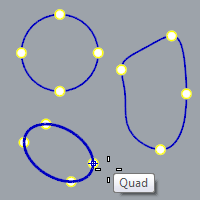
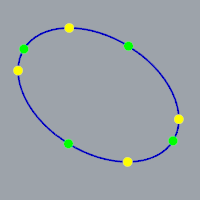
Snap tangent to a curve.
The Tan object snap is not effective for the first point for a command.
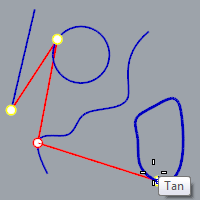
Snap to a mesh vertex.

When picking points during these steps, use simple snaps (End, Near, Point, Midpoint, Center, Intersection, and Quadrant) for greater precision.
Track along a line.
Start a circle located on the line between the center of the circle and the end of a line.
Track along a line parallel to a reference line between two points.
Start a line along a line parallel to the rectangle that passes through the circle's center.
Snap midway between two specified locations.
Center a circle between two rectangles
Snap from a specified base point.
Center a circle four units from the endpoint of a line.
Track along a line perpendicular to a curve.
Draw a line perpendicular from a line at the intersection with the circle.
Track along a line tangent to a curve.
Draw a line tangent from the circle at the intersection with the line.
Snap to and track along a selected curve for one pick.
Select the curve to move a control point along.
Snap to and track along a selected curve until the command completes.
Snap to and track over a polysurface for one pick.
Place a point object on a polysurface.
Snap to and track over a polysurface until the command completes.
Snap to and track along a selected mesh object for one pick.
Snap to and track along a selected mesh until the command completes.
Snap to and track over a surface for one pick.
Place a point object on a surface.
Snap to and track over a surface until the command completes.
Snap to a curve a percentage from the end.
The curve is marked with temporary black points that are automatically snapped to.
If the percentage is less than 50, the curve is marked with multiple snap points. For example, when using 30, you get snap points at 30%, 60% and 90%.
You can snap to surface isoparametric curves using the Int object snap whenever the input is constrained to a surface, for example in ExtractIsocurve, InsertKnot, OrientOnSrf, and with OnSrf, and OnPolysrf one-shot object snaps.
isoparametric curves object snapping is "weaker" than normal object snaps. The normal object snaps are evaluated first, and only if they fail will Rhino try to snap to the isoparametric curve intersections.
One-shot object snaps are automatically transparent. In other words, when scripting these, you do not need to use the apostrophe character to make the object snap work while a command is running.
| Toolbar | Menu | Status bar |
|---|---|---|
|
|
Tools Object Snap > <Options> |
The Osnap command sets the status of object snaps from the command line.
| Toolbar | Menu |
|---|---|
|
|
Tools Object Snap > Persistent Osnap Dialog |
The ShowOsnap command turns the Osnap control on, off, or toggles the current state.
| Command-line options | |
|---|---|
|
Show |
Turns the Osnap control on. |
|
Hide |
Turns the Osnap control off. |
|
Toggle |
Toggles the Osnap control. |
| Toolbar | Menu |
|---|---|
|
|
Tools Object Snap > Disable Object Snaps |
The DisableOsnap command manages the state of persistent object snaps.
| Command-line options | |
|---|---|
|
Enable |
|
|
Disable |
|
|
Toggle |
|
| Toolbar | Menu |
|---|---|
|
|
Tools Object Snap > Project to Plane |
The ProjectOsnap command projects object snaps from the actual snap point to the construction plane.
| Command-line options | |
|---|---|
|
Enable |
Object snaps will be projected to the construction plane. |
|
Disable |
Object snaps land on the object snapped to. |
|
Toggle |
|
| Toolbar | Menu |
|---|---|
|
|
Tools Object Snap > Snap To Locked Objects |
The SnapToLocked command snaps work on locked objects and on objects on locked layers.
| Toolbar | Menu |
|---|---|
|
|
|
The ToggleOsnapPanel command turns the display of the Object Snaps panel on and off.
| Toolbar | Menu |
|---|---|
|
|
|
The ToggleOsnapPanelUnderCursor shows or hides the Object Snaps in a floating panel and always places it under the cursor.
When you use this command, the Object Snaps panel also will disappear as soon as you move the cursor off the Object Snaps panel.
This command is intended to be used as a macro assigned to a mouse button if you have a mouse with more than three buttons or to a trackpad swipe gesture.
Rhino for Mac © 2010-2017 Robert McNeel & Associates. 24-Oct-2017